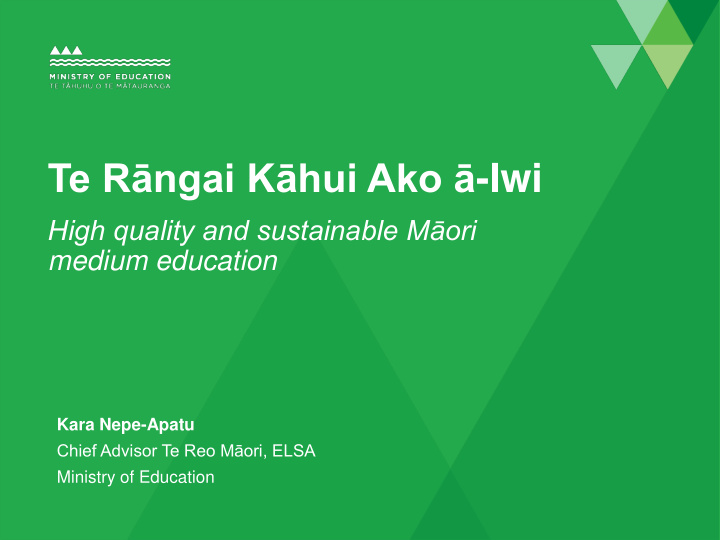



Te Rāngai Kāhui Ako ā -Iwi High quality and sustainable Māori medium education Kara Nepe-Apatu Chief Advisor Te Reo Māori, ELSA Ministry of Education
Māori language in education makes our system stronger • There are cognitive, cultural and social benefits from bilingualism for individuals and New Zealand as a whole. • Well-being is positively influenced by a clear sense of identity and exposure to language and culture. • Māori language in education contributes to the active protection of the Māori language as a taonga of iwi and Māori. • Learners of Māori medium education are more likely to achieve irrespective of traditional ‘risk’ factors. 2 education.govt.nz
What is Māori medium education? • Māori medium education includes all kura and settings where teaching occurs in and through te reo Māori for 51 -100 per cent of the time. These settings sit within immersion levels 1 and 2. • There are 279 Māori medium settings, with most of them located in the Auckland, Waikato, Bay of Plenty and Northland regions. Our Akonga • Within the schooling sector, there are: • 18,444 students in Māori medium education within the schooling sector; and • 161,381 students learning te reo Māori as a language. • There are approximately 178,000 tamariki learning in and through te reo Māori in early learning. 3 education.govt.nz
What do we know? • Māori medium education increases the ability of the education system to deliver for and with Māori learners, their families, whānau and iwi. • Students who stay in Māori medium education are more likely to achieve better . • Retention rates are poor as students transition from kohanga (22%), to kura/primary (12%), and wharekura/secondary (5%). • Regional specific needs must be met to ensure that all students in Māori medium education have access to quality outcomes. 4 education.govt.nz
Māori medium dependencies • Māori medium education is most successful when the following characteristics are present and strong: • Community and iwi context; • Whānau language and engagement; • Learning environment; • Governance, leadership and teachers. • Regardless of the size of provision, Māori medium education tends to flourish when all four of these factors are present. 5 education.govt.nz
Te Rāngai Kāhui Ako ā -Iwi The Framework 6 education.govt.nz
Measures • We used national data sets from the following agencies to support and measure the framework: • Ministry of Education • Education Review Office • Statistics New Zealand • Census • Te Kupenga. • We colour-coded the indicators to signal the current state: • Green = good • Yellow = developing • Red = critical. • These measures formed the basis of the current picture of Māori medium education by region. 7 education.govt.nz
Example of Demand 8 education.govt.nz
Example of Demand 9 9 education.govt.nz
Example of Supply 10 education.govt.nz
Example of Supply 11 education.govt.nz
Maps – Te Tai Tokerau 12 education.govt.nz
Maps - Tairāwhiti 13 education.govt.nz
What is the regional story telling us… • Focussing on supply, capacity and retention is a priority • Implement more deliberately focussed promotional information about Māori medium education with iwi and communities • Support whānau and schools to have access to language learning initiatives • Schools alone can’t build the pipeline we need. We must do this with iwi. 14 education.govt.nz
Next steps Short term/Immediate • Co-design regional action plans with iwi in 4 pilot regions – drafts due in August 2017 • Introductory hui with iwi remaining regions September-November 2017 • Develop national implementation plan to capture Ministry contributions to the regional plans Medium-Long term • Co-design regional action plans in remaining six regions • Refine and finalise national implementation plan 15 education.govt.nz
Where can I access Te Rāngai Kāhui Ako ā -Iwi? • Link to Te Rāngai Kāhui Ako ā -Iwi on the Ministry of Education website: https://education.govt.nz/ministry-of-education/specific- initiatives/te-rangai-kahui-ako-a-iwi/ 16 education.govt.nz
Recommend
More recommend